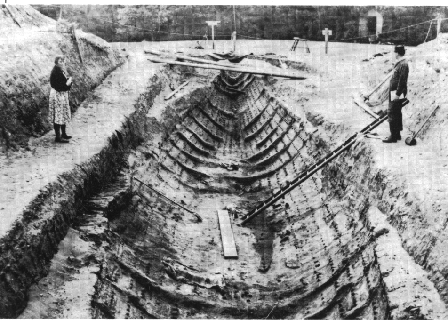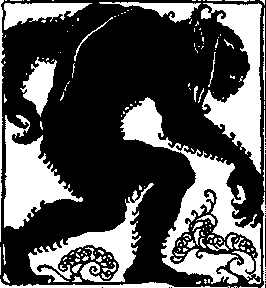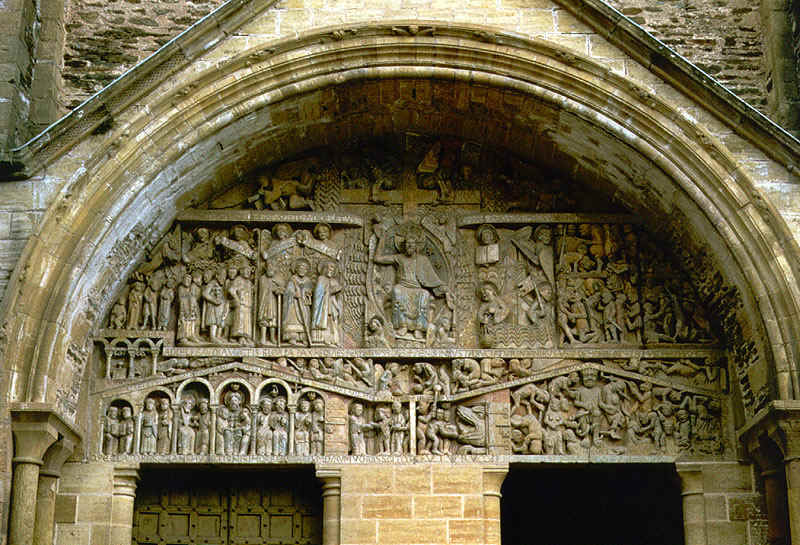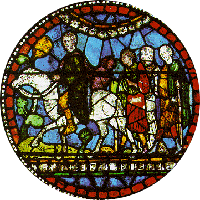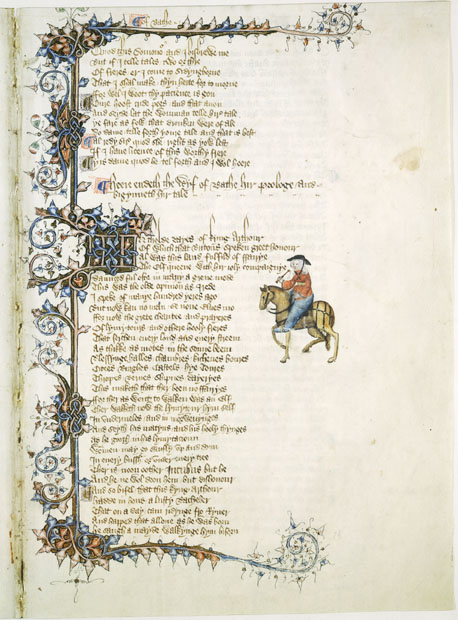OUT OF THE DARK AGES
Hwæt!What can be known about a unique poem in a unique manuscript, dated around the year 1000 a.d.? What do we know about the circumstances of its composition? Is it literary, oral, or something in-between? What can we never know? Beowulf is both strange and familiar: it has some links with ancient classical poems like Homer's; 19thc ideas of it have been received and reworked in the course of the 20thc in academe, children's literature and adult popular culture; and yet it remains an ancient artifact of a culture whose world we can never share. The manuscript and its editions always present us with a linguistic obstacle: Old English has a different kind of grammar from Modern. Old English is like Latin or Russian, or many other languages whose grammar is expressed by inflection: that is, affixes on a root word can stand in for function words like pronouns, so that a noun like "stow" will indicate its grammatical place in a sentence or clause by a series of endings: "... nis Þaet heoru stow!" (That is not a pleasant place!); or "He het þa þa stowe Dominus videt" (He named that place Dominus videt; or "on manegum stowum" (in many places). In an Old English sentence, especially in the poetry, syntax (the order of words) much more fluid than in Modern. Spelling will seem inconsistent, even random, in our terms; the alphabet contains some unfamiliar letters derived from runes. Translation of a language removed in kind and in time is a process of exploration, not a neat matching of word and idiom to sense, or the grammar of one language to the grammar of another. We will use translation as our primary means of reading Beowulf. What kind of overlap can be found between our written, literary experience of the poem, and its earlier oral delivery, which may have been memorized, reconstituted anew each time, and was always designed for being heard? Memory functions in different and often enhanced modes in oral rather than written cultures, especially when supported by verbal patterns evolved through centuries in a poetic or sung medium. Written literature may produce an intense impact, but rarely through its delivery; in Beowulf and other Old English poems, impact was always made through oral performance. When such poetry is written down, it is neither strictly oral nor graphic. (From: <www.humanities.mcmaster.ca/~beowulf/main.html> |
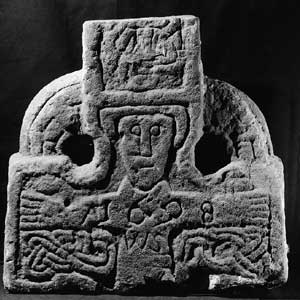 |
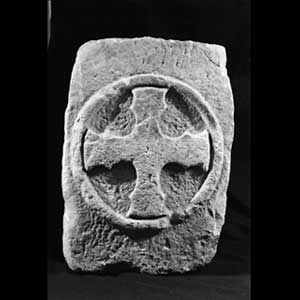 |
 |
| Anglo-Saxon Stone Sculpture in Northern Yorkshire |
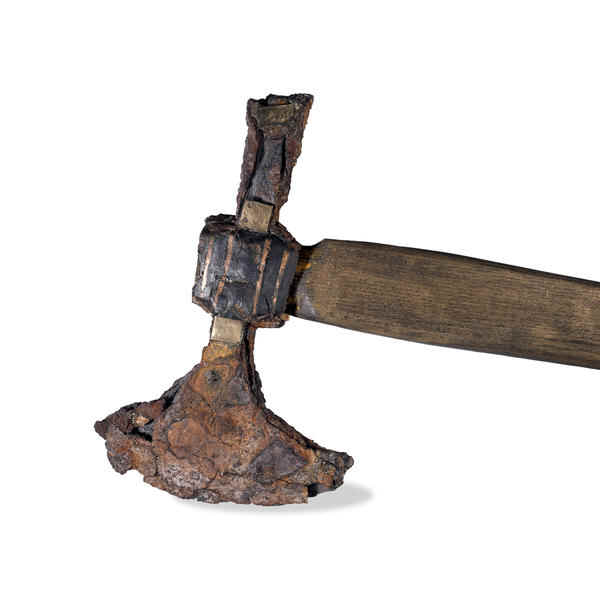 |
Stone axe -- 6th century - British Museum |
| Plot Overview King Hrothgar of Denmark, a descendant of the great king Shield Sheafson, enjoys a prosperous and successful reign. He builds a great mead-hall, called Heorot, where his warriors can gather to drink, receive gifts from their lord, and listen to stories sung by the scops, or bards. But the jubilant noise from Heorot angers Grendel, a horrible demon who lives in the swamplands of Hrothgar’s kingdom. Grendel terrorizes the Danes every night, killing them and defeating their efforts to fight back. The Danes suffer many years of fear, danger, and death at the hands of Grendel. Eventually, however, a young Geatish warrior named Beowulf hears of Hrothgar’s plight. Inspired by the challenge, Beowulf sails to Denmark with a small company of men, determined to defeat Grendel.
Hrothgar, who had once done a great favor for Beowulf’s father Edcgtheow, accepts Beowulf’s offer to fight Grendel and holds a feast in the hero's honor. During the feast, an envious Dane named Unferth taunts Beowulf and accuses him of being unworthy of his reputation. Beowulf responds with a boastful description of some of his past accomplishments. His confidence cheers the Danish warriors, and the feast lasts merrily into the night. At last, however, Grendel arrives. Beowulf fights him unarmed, proving himself stronger than the demon, who is terrified. As Grendel struggles to escape, Beowulf tears the monster’s arm off. Mortally wounded, Grendel slinks back into the swamp to die. The severed arm is hung high in mead-hall as a trophy of victory.
Overjoyed, Hrothgar showers Beowulf with gifts and treasure at a feast in his honor. Songs are sung in praise of Beowulf, and the celebration lasts late into the night. But another threat is approaching. Grendel’s mother, a swamp-hag who lives in a desolate lake, comes to Heorot seeking revenge for her son’s death. She murders Aeschere, one of Hrothgar’s most trusted advisers, before slinking away. To avenge Aeschere’s death, the company travels to the murky swamp, where Beowulf dives into the water and fights Grendel’s mother in her underwater lair. He kills her with a sword forged for a giant, then, finding Grendel’s corpse, decapitates it and brings the head as a prize to Hrothgar. The Danish countryside is now purged of its treacherous monsters. The Danes are again overjoyed, and Beowulf’s fame spreads across the kingdom. Beowulf departs after a sorrowful goodbye to Hrothgar, who has treated him like a son. He returns to Geatland, where he and his men are reunited with their king and queen, Hygelac and Hygd, to whom Beowulf recounts his adventures in Denmark. Beowulf then hands over most of his treasure to Hygelac, who, in turn, rewards him.
|
 |
 |
Bayeux Tapestries |
CHAUCER
Background
The Canterbury Tales is the most famous and critically acclaimed
work of Geoffrey Chaucer, a late-fourteenth-century English poet. Little is known about
Chaucer’s personal life, and even less about his education, but a number of existing
records document his professional life. Chaucer was born in London in the early 1340s, the only son in his family. Chaucer’s father,
originally a property-owning wine merchant, became tremendously wealthy when he inherited
the property of relatives who had died in the Black Death of 1349.
He was therefore able to send the young Geoffrey off as a page to the Countess of Ulster,
which meant that Geoffrey was not required to follow in his ancestors’ footsteps and
become a merchant. Eventually, Chaucer began to serve the countess’s husband, Prince
Lionel, son to King Edward III. For most of his life, Chaucer served in the Hundred Years
War between England and France, both as a soldier and, since he was fluent in French and
Italian and conversant in Latin and other tongues, as a diplomat. His diplomatic travels
brought him twice to Italy, where he might have met Boccaccio, whose writing influenced
Chaucer’s work, and Petrarch. In or around 1378,
Chaucer began to develop his vision of an English poetry that would be linguistically
accessible to all—obedient neither to the court, whose official language was French,
nor to the Church, whose official language was Latin. Instead, Chaucer wrote in the
vernacular, the English that was spoken in and around London in his day. Undoubtedly, he
was influenced by the writings of the Florentines Dante, Petrarch, and Boccaccio, who
wrote in the Italian vernacular. Even in England, the practice was becoming increasingly
common among poets, although many were still writing in French and Latin. That the nobles and kings Chaucer served
(Richard II until 1399, then Henry IV) were impressed with
Chaucer’s skills as a negotiator is obvious from the many rewards he received for his
service. Money, provisions, higher appointments, and property eventually allowed him to
retire on a royal pension. In 1374, the king appointed
Chaucer Controller of the Customs of Hides, Skins and Wools in the port of London, which
meant that he was a government official who worked with cloth importers. His experience
overseeing imported cloths might be why he frequently describes in exquisite detail the
garments and fabric that attire his characters. Chaucer held the position at the
customhouse for twelve years, after which he left London for Kent, the county in which
Canterbury is located. He served as a justice of the peace for Kent, living in debt, and
was then appointed Clerk of the Works at various holdings of the king, including
Westminster and the Tower of London. After he retired in the early 1390s, he seems to have been working primarily on The Canterbury Tales, which he began around 1387. By the time of his retirement, Chaucer had already written
a substantial amount of narrative poetry, including the celebrated romance Troilus and Criseyde. Chaucer’s personal life is less
documented than his professional life. In the late 1360s,
he married Philippa Roet, who served Edward III’s queen. They had at least two sons
together. Philippa was the sister to the mistress of John of Gaunt, the duke of Lancaster.
For John of Gaunt, Chaucer wrote one of his first poems, The
Book of the Duchess, which was a lament for the premature death of John’s
young wife, Blanche. Chaucer lived through a time of
incredible tension in the English social sphere. The Black Death, which ravaged England
during Chaucer’s childhood and remained widespread afterward, wiped out an estimated
thirty to fifty percent of the population. Consequently, the labor force gained increased
leverage and was able to bargain for better wages, which led to resentment from the nobles
and propertied classes. These classes received another blow in 1381,
when the peasantry, helped by the artisan class, revolted against them. The merchants were
also wielding increasing power over the legal establishment, as the Hundred Years War
created profit for England and, consequently, appetite for luxury was growing. The
merchants capitalized on the demand for luxury goods, and when Chaucer was growing up,
London was pretty much run by a merchant oligarchy, which attempted to control both the
aristocracy and the lesser artisan classes. Chaucer’s political sentiments are
unclear, for although The Canterbury Tales documents
the various social tensions in the manner of the popular genre of estates satire, the
narrator refrains from making overt political statements, and what he does say is in no
way thought to represent Chaucer’s own sentiments. Chaucer’s original plan for The Canterbury Tales was for each character to tell four
tales, two on the way to Canterbury and two on the way back. But, instead of 120 tales, the text ends after twenty-four tales, and the party
is still on its way to Canterbury. Chaucer either planned to revise the structure to cap
the work at twenty-four tales, or else left it incomplete when he died on October 25, 1400. Other writers and
printers soon recognized The Canterbury Tales as a
masterful and highly original work. Though Chaucer had been influenced by the great French
and Italian writers of his age, works like Boccaccio’s Decameron
were not accessible to most English readers, so the format of The Canterbury Tales, and the intense realism of its
characters, were virtually unknown to readers in the fourteenth century before Chaucer.
William Caxton, England’s first printer, published The
Canterbury Tales in the 1470s, and it continued to
enjoy a rich printing history that never truly faded. By the English Renaissance, poetry
critic George Puttenham had identified Chaucer as the father of the English literary
canon. Chaucer’s project to create a literature and poetic language for all classes
of society succeeded, and today Chaucer still stands as one of the great shapers of
literary narrative and character.
Language in The Canterbury Tales The
Canterbury Tales is written in Middle English, which bears a close visual
resemblance to the English written and spoken today. In contrast, Old English (the
language of Beowulf, for example) can be read only in modern translation or by students of
Old English. Students often read The Canterbury Tales
in its original language, not only because of the similarity between Chaucer’s Middle
English and our own, but because the beauty and humor of the poetry—all of its
internal and external rhymes, and the sounds it produces—would be lost in
translation. The best way for a beginner to approach
Middle English is to read it out loud. When the words are pronounced, it is often much
easier to recognize what they mean in modern English. Most Middle English editions of the
poem include a short pronunciation guide, which can help the reader to understand the
language better. For particularly difficult words or phrases, most editions also include
notes in the margin giving the modern versions of the words, along with a full glossary in
the back. Several online Chaucer glossaries exist, as well as a number of printed lexicons
of Middle English.
The Order of The Canterbury Tales The tales are grouped together into fragments, and each fragment is numbered as a separate
whole. Nobody knows exactly what order
Chaucer intended to give the tales, or even if he had a specific order in mind for all of
them. Eighty-two early manuscripts of the tales survive, and many of them vary
considerably in the order in which they present the tales. However, certain sets of tales
do seem to belong together in a particular order. For instance, the General Prologue is
obviously the beginning, then the narrator explicitly says that the Knight tells the first
tale, and that the Miller butts in and tells the second tale. The introductions,
prologues, and epilogues to various tales sometimes include the pilgrims’ comments on
the tale just finished, and an indication of who tells the next tale. These sections
between the tales are called links, and they are the
best evidence for grouping the tales together into ten fragments. But The Canterbury Tales does not include a complete set of
links, so the order of the ten fragments is open to question. The Riverside Chaucer bases the order of the ten fragments
on the order presented in the Ellesmere manuscript, one of the best surviving manuscripts
of the tale. Some scholars disagree with the groupings and order of tales followed in The Riverside Chaucer, choosing instead to base the order
on a combination of the links and the geographical landmarks that the pilgrims pass on the
way to Canterbury. |
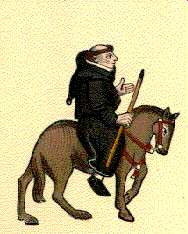 |
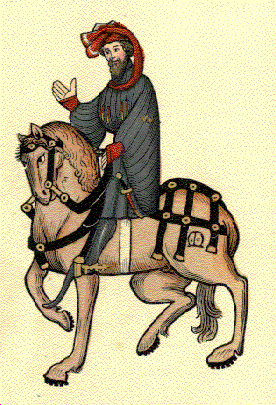 |
The Friar |
The Knight |
 |
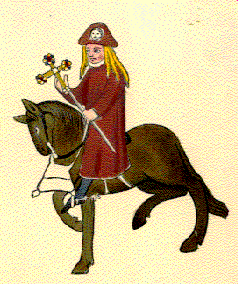 |
The Prioress |
The Pardoner |
 |
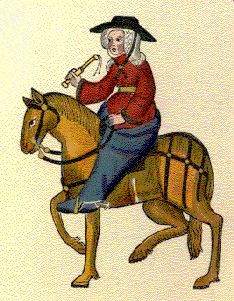 |
The Squire |
The Wife of Bath |
| (All woodcuts from the Ellesmere text) |
The Canterbury TalesPlot Overview
General Prologue At the Tabard Inn, a tavern in
Southwark, near London, the narrator joins a company of twenty-nine pilgrims. The
pilgrims, like the narrator, are traveling to the shrine of the martyr Saint Thomas Becket
in Canterbury. The narrator gives a descriptive account of twenty-seven of these pilgrims,
including a Knight, Squire, Yeoman, Prioress, Monk, Friar, Merchant, Clerk, Man of Law,
Franklin, Haberdasher, Carpenter, Weaver, Dyer, Tapestry-Weaver, Cook, Shipman, Physician,
Wife, Parson, Plowman, Miller, Manciple, Reeve, Summoner, Pardoner, and Host. (He does not
describe the Second Nun or the Nun’s Priest, although both characters appear later in
the book). The host, whose name, we find out
in the Prologue to the Cook’s Tale, is Harry Bailey, suggests that the group ride
together and entertain one another with stories. He decides that each pilgrim will tell
two stories on the way to Canterbury and two on the way back. Whomever he judges to be the
best storyteller will receive a meal at Bailey’s tavern, courtesy of the other
pilgrims. The pilgrims draw lots and determine that the Knight will tell the first tale. (Here are summaries of a few of the tales). The
Knight’s Tale Theseus, duke of Athens, imprisons Arcite
and Palamon, two knights from Thebes (another city in ancient Greece). From their prison,
the knights see and fall in love with Theseus’s sister-in-law, Emelye. Through the
intervention of a friend, Arcite is freed, but he is banished from Athens. He returns in
disguise and becomes a page in Emelye’s chamber. Palamon escapes from prison, and the
two meet and fight over Emelye. Theseus apprehends them and arranges a tournament between
the two knights and their allies, with Emelye as the prize. Arcite wins, but he is
accidentally thrown from his horse and dies. Palamon then marries Emelye.
The Miller’s Prologue and Tale The Host asks the Monk to tell the next
tale, but the drunken Miller butts in and insists that his tale should be the next. He
tells the story of an impoverished student named Nicholas, who persuades his
landlord’s attractive and bored young wife, Alisoun, to spend the night with him. He
convinces his landlord, a carpenter named John, that the second flood is coming, and
tricks him into spending the night in a tub hanging from the ceiling of his barn. Absolon, a young parish clerk who is also in love
with Alisoun, appears outside the window of the room where Nicholas and Alisoun lie
together. When Absolon begs Alisoun for a kiss, she sticks her rear end out the window in
the dark and lets him kiss it. Absolon runs and gets a red-hot poker, returns to the
window, and asks for another kiss; when Nicholas sticks his bottom out the window and
farts, Absolon brands him on the buttocks. Nicholas’s cries for water make the
carpenter think that the flood has come, so the carpenter cuts the rope connecting his tub
to the ceiling, falls down, and breaks his arm.
The Wife of Bath’s Prologue and Tale The Wife of Bath gives a lengthy account
of her feelings about marriage. Quoting from the Bible, the Wife argues against those who
believe it is wrong to marry more than once, and she explains how she dominated and
controlled each of her five husbands. She married her fifth husband, Jankyn, for love
instead of money. After the Wife has rambled on for a while, the Friar butts in to
complain that she is taking too long, and the Summoner retorts that friars are like flies,
always meddling. The Friar promises to tell
a tale about a summoner, and the Summoner promises to tell a tale about a friar. The Host
cries for everyone to quiet down and allow the Wife to commence her tale. In her tale, a young knight of King
Arthur’s court rapes a maiden; to atone for his crime, Arthur’s queen sends him
on a quest to discover what women want most. An ugly old woman promises the knight that
she will tell him the secret if he promises to do whatever she wants for saving his life.
He agrees, and she tells him women want control of their husbands and their own lives.
They go together to Arthur’s queen, and the old woman’s answer turns out to be
correct. The old woman then tells the knight that he must marry her. When the knight
confesses later that he is repulsed by her appearance, she gives him a choice: she can
either be ugly and faithful, or beautiful and unfaithful. The knight tells her to make the
choice herself, and she rewards him for giving her control of the marriage by rendering
herself both beautiful and faithful.
The Friar’s Prologue and Tale The Friar speaks approvingly of the Wife
of Bath’s Tale, and offers to lighten things up for the company by telling a funny
story about a lecherous summoner. The Summoner does not object, but he promises to pay the
Friar back in his own tale. The Friar tells of an archdeacon who carries out the law
without mercy, especially to lechers. The archdeacon has a summoner who has a network of
spies working for him, to let him know who has been lecherous. The summoner extorts money
from those he’s sent to summon, charging them more money than he should for penance.
He tries to serve a summons on a yeoman who is actually a devil in disguise. After
comparing notes on their treachery and extortion, the devil vanishes, but when the
summoner tries to prosecute an old wealthy widow unfairly, the widow cries out that the
summoner should be taken to hell. The devil follows the woman’s instructions and
drags the summoner off to hell.
The Summoner’s Prologue and Tale The Summoner, furious at the Friar’s
Tale, asks the company to let him tell the next tale. First, he tells the company that
there is little difference between friars and fiends, and that when an angel took a friar
down to hell to show him the torments there, the friar asked why there were no friars in
hell; the angel then pulled up Satan’s tail and 20,000 friars came out of his ass. In the Summoner’s Tale, a friar begs
for money from a dying man named Thomas and his wife, who have recently lost their child.
The friar shamelessly exploits the couple’s misfortunes to extract money from them,
so Thomas tells the friar that he is sitting on something that he will bequeath to the
friars. The friar reaches for his bequest, and Thomas lets out an enormous fart. The friar
complains to the lord of the manor, whose squire promises to divide the fart evenly among
all the friars.
The Parson’s Prologue and Tale As the company enters a village in the
late afternoon, the Host calls upon the Parson to give them a fable. Refusing to tell a
fictional story because it would go against the rule set by St. Paul, the Parson delivers
a lengthy treatise on the Seven Deadly Sins, instead.
Chaucer’s Retraction Chaucer appeals to readers to credit
Jesus Christ as the inspiration for anything in his book that they like, and to attribute
what they don’t like to his own ignorance and lack of ability. He retracts and prays
for forgiveness for all of his works dealing with secular and pagan subjects, asking only
to be remembered for what he has written of saints’ lives and homilies. (excerpt from Sparknotes.com) |
The Wife of Bath’s
Prologue
The
Wife of Bath begins the Prologue to her tale by establishing herself as an authority on
marriage, due to her extensive personal experience with the institution. Since her first
marriage at the tender age of twelve, she has had five husbands. She says that many people
have criticized her for her numerous marriages, most of them on the basis that Christ went
only once to a wedding, at Cana in Galilee. The Wife of Bath has her own views of
Scripture and God’s plan. She says that men can only guess and interpret what Jesus
meant when he told a Samaritan woman that her fifth husband was not her husband. With or
without this bit of Scripture, no man has ever been able to give her an exact reply when
she asks to know how many husbands a woman may have in her lifetime. God bade us to wax
fruitful and multiply, she says, and that is the text that she wholeheartedly endorses.
After all, great Old Testament figures, like Abraham, Jacob, and Solomon, enjoyed multiple
wives at once. She admits that many great Fathers of the Church have proclaimed the
importance of virginity, such as the Apostle Paul. But, she reasons, even if virginity is
important, someone must be procreating so that virgins can be created. Leave virginity to
the perfect, she says, and let the rest of us use our gifts as best we may—and her
gift, doubtless, is her sexual power. She uses this power as means to control her
husbands. At this point, the Pardoner interrupts. He
is planning to marry soon and worries that his wife will control his body, as the Wife of
Bath describes. The Wife of Bath tells him to have patience and to listen to the whole
tale to see if it reveals the truth about marriage. Of her five husbands, three have been
“good” and two have been “bad.” The first three were good, she admits,
mostly because they were rich, old, and submissive. She laughs to recall the torments that
she put these men through and recounts a typical conversation that she had with her older
husbands. She would accuse her -husband of having an affair, launching into a tirade in
which she would charge him with a bewildering array of accusations. If one of
her husbands got drunk, she would claim he said that every wife is out to destroy her
husband. He would then feel guilty and give her what she wanted. All of this, the Wife of
Bath tells the rest of the pilgrims, was a pack of lies—her husbands never held these
opinions, but she made these claims to give them grief. Worse, she would tease her
husbands in bed, refusing to give them full satisfaction until they promised her money.
She admits proudly to using her verbal and sexual power to bring her husbands to total
submission.
Analysis In her lengthy Prologue, the Wife of Bath
recites her autobiography, announcing in her very first word that “experience”
will be her guide. Yet, despite her claim that experience is her sole authority, the Wife
of Bath apparently feels the need to establish her authority in a more scholarly way. She
imitates the ways of churchmen and scholars by backing up her claims with quotations from
Scripture and works of antiquity. The Wife carelessly flings around references as textual
evidence to buttress her argument, most of which don’t really correspond to her
points. Her reference to Ptolemy’s Almageste,
for instance, is completely erroneous—the phrase she attributes to that book appears
nowhere in the work. Although her many errors display her lack of real scholarship, they
also convey Chaucer’s mockery of the churchmen present, who often misused Scripture
to justify their devious actions. The text of the Wife of Bath’s
Prologue is based in the medieval genre of allegorical “confession.” In a
morality play, a personified vice such as Gluttony or Lust “confesses” his or
her sins to the audience in a life story. The Wife is exactly what the medieval Church saw
as a “wicked woman,” and she is proud of it—from the very beginning, her
speech has undertones of conflict with her patriarchal society. Because the statements
that the Wife of Bath attributes to her husbands were taken from a number of satires
published in Chaucer’s time, which half-comically portrayed women as unfaithful,
superficial, evil creatures, always out to undermine their husbands, feminist critics have
often tried to portray the Wife as one of the first feminist characters in literature. This interpretation is weakened by the
fact that the Wife of Bath herself conforms to a number of these misogynist and misogamist
(antimarriage) stereotypes. For example, she describes herself as sexually voracious but
at the same time as someone who only has sex to get money, thereby combining two
contradictory stereotypes. She also describes how she dominated her husband, playing on a
fear that was common to men, as the Pardoner’s nervous interjection reveals. Despite
their contradictions, all of these ideas about women were used by men to support a
hierarchy in which men dominated women. |
Please go to the Discussion for Week 5

